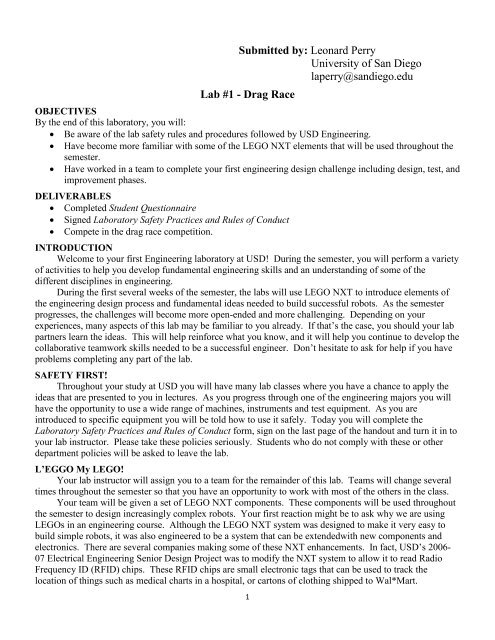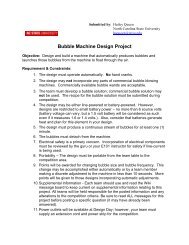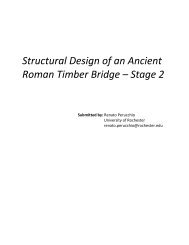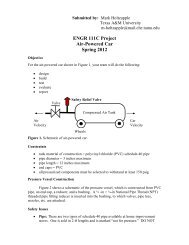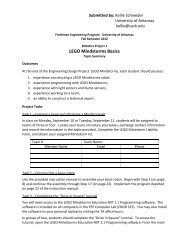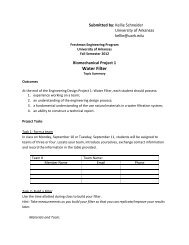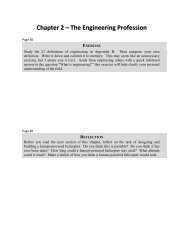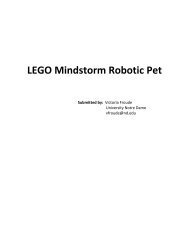P90 - LEGO NXT Project 1 - Discovery Press
P90 - LEGO NXT Project 1 - Discovery Press
P90 - LEGO NXT Project 1 - Discovery Press
You also want an ePaper? Increase the reach of your titles
YUMPU automatically turns print PDFs into web optimized ePapers that Google loves.
Submitted by: Leonard PerryUniversity of San Diegolaperry@sandiego.eduLab #1 - Drag RaceOBJECTIVESBy the end of this laboratory, you will:• Be aware of the lab safety rules and procedures followed by USD Engineering.• Have become more familiar with some of the <strong>LEGO</strong> <strong>NXT</strong> elements that will be used throughout thesemester.• Have worked in a team to complete your first engineering design challenge including design, test, andimprovement phases.DELIVERABLES• Completed Student Questionnaire• Signed Laboratory Safety Practices and Rules of Conduct• Compete in the drag race competition.INTRODUCTIONWelcome to your first Engineering laboratory at USD! During the semester, you will perform a varietyof activities to help you develop fundamental engineering skills and an understanding of some of thedifferent disciplines in engineering.During the first several weeks of the semester, the labs will use <strong>LEGO</strong> <strong>NXT</strong> to introduce elements ofthe engineering design process and fundamental ideas needed to build successful robots. As the semesterprogresses, the challenges will become more open-ended and more challenging. Depending on yourexperiences, many aspects of this lab may be familiar to you already. If that’s the case, you should your labpartners learn the ideas. This will help reinforce what you know, and it will help you continue to develop thecollaborative teamwork skills needed to be a successful engineer. Don’t hesitate to ask for help if you haveproblems completing any part of the lab.SAFETY FIRST!Throughout your study at USD you will have many lab classes where you have a chance to apply theideas that are presented to you in lectures. As you progress through one of the engineering majors you willhave the opportunity to use a wide range of machines, instruments and test equipment. As you areintroduced to specific equipment you will be told how to use it safely. Today you will complete theLaboratory Safety Practices and Rules of Conduct form, sign on the last page of the handout and turn it in toyour lab instructor. Please take these policies seriously. Students who do not comply with these or otherdepartment policies will be asked to leave the lab.L’EGGO My <strong>LEGO</strong>!Your lab instructor will assign you to a team for the remainder of this lab. Teams will change severaltimes throughout the semester so that you have an opportunity to work with most of the others in the class.Your team will be given a set of <strong>LEGO</strong> <strong>NXT</strong> components. These components will be used throughoutthe semester to design increasingly complex robots. Your first reaction might be to ask why we are using<strong>LEGO</strong>s in an engineering course. Although the <strong>LEGO</strong> <strong>NXT</strong> system was designed to make it very easy tobuild simple robots, it was also engineered to be a system that can be extendedwith new components andelectronics. There are several companies making some of these <strong>NXT</strong> enhancements. In fact, USD’s 2006-07 Electrical Engineering Senior Design <strong>Project</strong> was to modify the <strong>NXT</strong> system to allow it to read RadioFrequency ID (RFID) chips. These RFID chips are small electronic tags that can be used to track thelocation of things such as medical charts in a hospital, or cartons of clothing shipped to Wal*Mart.1
USD ENGR 101 Lab #1 – Drag Race Fall 2011You should spend 10 minutes or so examining the <strong>NXT</strong> components. You won’t be using thecontroller or the sensors this week, so you should focus on the wheels, axles, gears and connectors. How canyou combine these items to make a vehicle? The Appendix summarizes some principles of <strong>LEGO</strong>construction and has notes on gears, but there are many ways to build things with these elements.DESIGN CHALLENGE #1 – <strong>LEGO</strong> DRAG RACEChallenge:To design and build a <strong>LEGO</strong> vehicle that travels the greatest distance when powered only bya rubber band.Procedure:Phase I:• You have 30 minutes to design, build and test a rubber-band powered vehicle. The official rubberbandswill be supplied by the instructor. You may use only one rubber band and any items in the<strong>LEGO</strong> kit.• The winner is determined as the longest distance traveled. The distance traveled is defined as distancefrom the start line to the <strong>LEGO</strong> piece closest to the start line.Phase II:• You will have 15 minutes to redesign your vehicle. You may not begin to redesign until after allteams have completed Phase I.• No points will be awarded in Phase II.• Teams will compete in the reverse order of Phase I.Phase III:• You have 15 minutes to re-design your vehicle once more. You may not begin to redesign until afterall teams have completed Phase II.• The winner is determined as the longest distance traveled.• Teams will compete in random order determined by the instructor.Scoring:Your score will be based 70% on distance traveled (30 pts max for Phase I and 40 pts max for phase III) and30% on the overall creativity and aesthetics of your vehicle. The Design & Aesthetics points will beevaluated before the final round of the competition.Total Points available for this lab: 100Scoring Guideline:Phase IDistance30 pts - Winner!28 pts - Moved 15+ ft26 pts - Moved 10+ ft23 pts - Moved forward20 pts - Moved15 pts - Didn’t Move0 pts– No entryDesign &Aesthetics30 pts - Best design28 pts - Outstanding26 pts - Some cleverfeatures23 pts - Good20 pts - Nothing special15 pts - Downright uglyPhase IIIDistance40 pts - Winner!38 pts - Moved 15+ ft34 pts - Moved 10+ ft30 pts - Moved forward26 pts - Moved20 pts - Didn’t Move0 pts– No entryCLEAN-UPAfter you have finished with the challenge you should completely dismantle your vehicle, place theparts in the tote, and return everything to your lab instructor.2
USD ENGR 101 Lab #1 – Drag Race Fall 2011APPENDIX<strong>LEGO</strong> <strong>NXT</strong> Construction TipsWhen building your robot you may need to make strong connections that will support tension orcompression. These pictures illustrate some simple ways to connect components. In each case the figure onthe left is an exploded view version of the completed assembly on the right.The dark beams in these figures will support compression, but can come apart under tension.In the figures below, additional the beams have been reinforced to support both compression and tension, butthey are much more complicated to build.3
USD ENGR 101 Lab #1 – Drag Race Fall 2011<strong>LEGO</strong> <strong>NXT</strong> Gear Tips(From materials at the Carnegie Mellon University Robotics Institute)The <strong>LEGO</strong> <strong>NXT</strong> system comes with several types of gears that can be used to change the speed or forcedelivered by the motor, or to rotate parts of your robot. This page illustrates the use of some of these gears.Spur gears are the most common gear in the <strong>LEGO</strong> <strong>NXT</strong> system.Spur gears do three things:• Change the speed of rotation• Change the torque delivered• Cause a change in directionMating spur gears rotate in opposite directions. The gear ratio is theratio of the number of teeth on one gear to the number of teeth on theother gear. For the gears shown at the right the gear ratio is 40 to 8 or,5:1. This also means the 40 tooth gear’s axle has 5 times the torque asthe 8 tooth gear’s axle and 1/5 the rotational speed.Idler gears are spur gears placed between two identically sized gears. Idlergears do not change the gear ratio. They do cause the gears on either side to turnin the same direction. Here the 40 tooth gear acts as an idler gear between two8T gears.8 Teeth 40 TeethBevel gearsmesh at a 90 degree angle. The gear ratio rules remain the same, butthe axles are perpendicular to one another. <strong>LEGO</strong> <strong>NXT</strong> includes unusual bevelgears with curved teeth that mesh with spur gears and bevel gears.Worm gears have a single tooth that wraps around its axis of rotation. Becauseit acts as a gear with one tooth it has a very high gear ratio.You can turn theworm gear’s axle, but you can’t turn the spur gear’s axle.Belts & pulleys are related to gears. They change speed and torque,but:• Pulleys transfer their force by the friction of the belts, rather thandirect contact with the teeth of gears. As a result the belts canslip.• The pulleys rotate in the same direction.4


